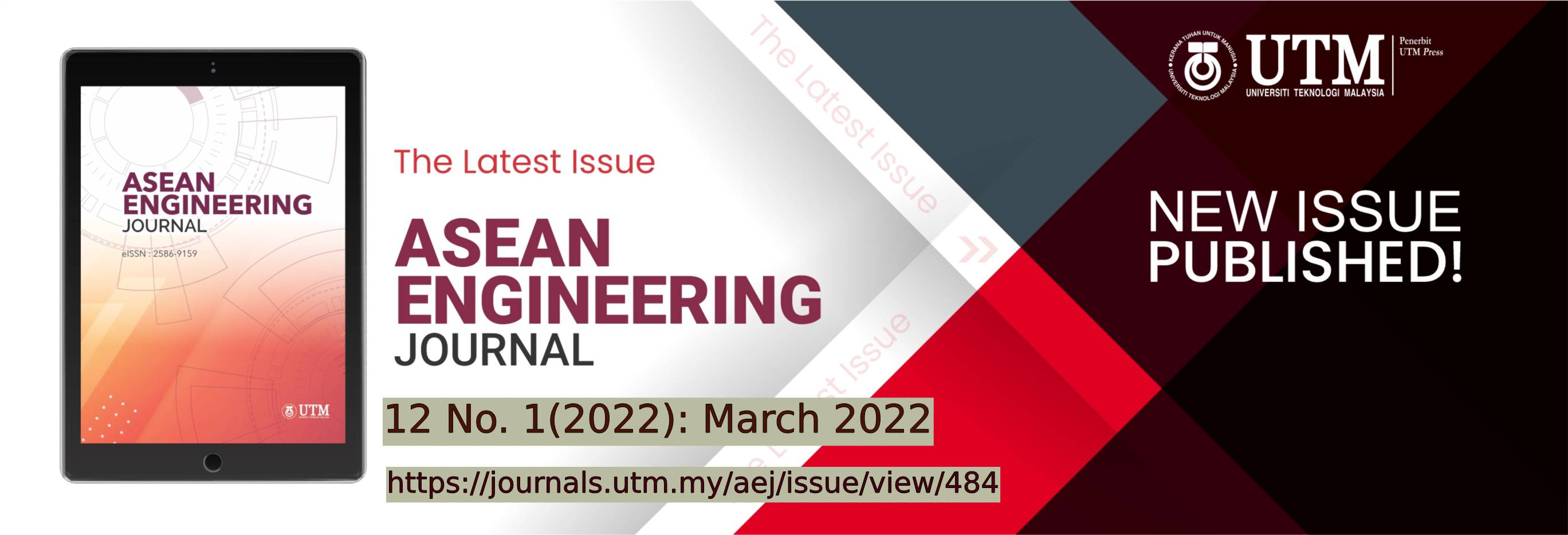ALKALI SILICA REACTION OF RECYCLED GLASS AGGREGATE MORTAR USING FLY ASH UNDER STEAM CURING
DOI:
https://doi.org/10.11113/aej.v12.17303Keywords:
Recycled glass aggregate, alkali-silica reaction, steam curing, fly ashAbstract
Utilization of recycled glass as fine and coarse aggregates in concrete materials can give significant economical and environmental benefits, especially in the case of developing countries. However, alkali-silica reaction (ASR) will be a serious problem when the recycled glass is used as concrete aggregates. This paper shows an investigation of the alkali-silica reaction of glass sand mortar under steam curing. The test for ASR expansion follows ASTM C1567. Type F fly ash (FA) is used together with Ordinary Portland cement (OPC) mixing with mixed color glass sand. FA contents are of 20%, 30%, 40% and 50% as OPC replacement. Steam curing accelerating FA reaction is used to contribute to the mitigation of ASR by strength improvement of the mortar. Under steam curing, the results show that the recommended contents of FA to use are of 20% to 30% to ensure expansion lower than the threshold of ASTM. Moreover, steam curing increases the expansion of the glass sand mortar in compared to the moist curing, and expansion crack appears at the interface between glass sand and cementitious matrix, not in the glass sand. In comparison with glass sand mortar under moist curing, expansion of glass sand mortar using fly ash under steam curing is contributed primarily by: (1) delayed ettringite formation, (2) reducing ion transportation, (3) increasing tensile strength of fly ash glass sand mortar and (4) reducing glass sand dissolution rate in rich alkalinity solution.
References
Tuncan M, Karasu B and Yalcin M, 2001.“The suitability for using glass and fly ash in Portland cement concrete,” Proceedings of the 11th International Offshore and Polar Engineering Conference (ISOPE2001), Stavenger, Norway, 146 – 152,
Park SB, Lee BC and Kim JH. 2004., “Studies on mechanical properties of concrete containing waste glass aggregate,” Cement and Concrete Research, 34(12): 2181 – 2189, DOI: https://doi.org/10.1016/j.cemconres.2004.02.006
Du H, and Tan KH, 2014.“Concrete with recycled glass as fine aggregates,”, ACI Materials Journal, 111–M05: 47 – 58, DOI: https://doi.org/10.14359/51686446
Adaway M and Wang Y, 2015.“Recycled glass as a partial replacement for fine aggregate in structural concrete – Effects on compressive strength,”, Electronic Journal of Structural Engineering, 14(1): 116 – 122.
Farshad Rajabipour, Hamed Maraghechi and Gregor Fischer, 2010. “Investigating the Alkali – Silica Reaction of Recycled Glass Aggregates in Concrete Materials,” Journal of Materials in Civil Engineering of ASCE, 22(12): 1201 – 1208, DOI: https://doi.org/10.1061/(ASCE)MT.1943-5533.0000126
Hongjian Du and Kiang Hwee Tan, 2014.“Effect of particle size on alkali – silica reaction in recycled glass mortars,” Construction and Building Materials, 66: 275–285, DOI: https://doi.org/10.1016/j.conbuildmat.2014.05.092
Nathan Schwarz, Hieu Cam and Narayanan Neithalath, 2008.“Influence of a fine glass powder on the durability characteristics of concrete and its comparison to fly ash,” Cement and Concrete Composites, 30: 486 – 496, DOI: https://doi.org/10.1016/j.cemconcomp.2008.02.001
Kaveh Afshinnia and Prasada Rao Rangaraju, 2015.“Influence of finess ground recycled glass on mitigation of alkali – silica reaction in mortars,” Construction and Building Materials, 81: 257 – 267, DOI: https://doi.org/10.1016/j.conbuildmat.2015.02.041
Seyed M.H. Shafaatian, Alireza Akhavan, Hamed Maraghechi and Farshad Rajabipour, 2013.“How does fly ash mitigate alkali-silica reaction (ASR) in accelerated mortar bar test (ASTM C1567)?, ” Cement & Concrete Composites, 37: 143 – 153, DOI: https://doi.org/10.1016/j.cemconcomp.2012.11.004
Polley C, Cramer S.M and de la Cruz R.V, 1998.“Potential for using waste glass in portland cement concrete,” Journal of Materials in Civil Engineering of ASCE, 10(4): 210 – 219, DOI: https://doi.org/10.1061/(ASCE)0899-1561(1998)10:4(210)
Thomas MDA, 2011.“The effect of supplementary cementing materials on alkali-silica reaction: a review, ” Cement and Concrete Research, 41: 1224 – 1231, DOI: https://doi.org/10.1016/j.cemconres.2010.11.003
Dustan ER, 1981.“The effect of fly ash on concrete alkali-aggregate reaction,” Cement, Concrete and Aggregates, 3: 101 – 104, DOI: https://doi.org/10.1520/CCA10212J
Lothenbach B, Scrivener K and Hooton RD, 2011.“Supplementary cementitious materials,” Cement and Concrete Research, 41: 1244 – 1256, DOI: https://doi.org/10.1016/j.cemconres.2010.12.001
Moser RD, Jayapalan AR, Garas VY and Kurtis KE, 2010.“Assessment of binary and ternary blends of metakaolin and class C fly ash for alkali-silica reaction mitigation in concrete,” Cement and Concrete Research, 40: 1664 – 1672, DOI: https://doi.org/10.1016/j.cemconres.2010.08.006
Shehata MH and Thomas MDA, 2010.“The effect of fly ash composition on the expansion of concrete due to alkali-silica reaction,” Cement and Concrete Research, 30(7): 1063 – 1072, DOI: https://doi.org/10.1016/S0008-8846(00)00283-0
Shehata MH and Thomas MDA, 2006.“Alkali release characteristics of blended cements,” Cement and Concrete Research, 36(6): 1166 – 1175, DOI: https://doi.org/10.1016/j.cemconres.2006.02.015
Halit Yazici, Serdar Aydin, Huseyin Yigiter and Bulent Baradan, 2005.“Effect of steam curing on class C high-volume fly ash concrete mixtures,” Cement and Concrete Reasearch, 35: 1122 – 1127, DOI: https://doi.org/10.1016/j.cemconres.2004.08.011
Weiping Ma and Paul W.Brown, 1997.“Hydrothermal reactions of fly ash with Ca(OH)2 and CaSO4.2H2O,” Cement and Concrete Research, 27(8): 1237 – 1248, DOI: https://doi.org/10.1016/S0008-8846(97)00116-6
Mongkhon Narmluk and Toyoharu Nawa, 2014.‘‘Effect of curing temperatyre on pozzolanic reaction of fly ash in blended cement paste,’’ International Journal of Chemical Engineering and Applications, 5(1): 31 – 35, DOI: https://doi.org/10.7763/IJCEA.2014.V5.346
Kjellsen K.O, Detwiler R.J and Gjorov O.E, 1990.“Pore Structure of Plain cement pastes hydrated at different temperature,” Cement and Concrete Research, 20: 927 – 933, DOI: https://doi.org/10.1016/0008-8846(90)90055-3
ASTM C1567-11, 2011.‘‘Standard test method for determining the potential alkali-silica reactivity of combinations of cementitious materials and aggregate (accelerated mortar-bar method),’’ American Society for Testing and Materials, West Conshohocken, Pennsylvania, USA.
ASTM C348-21, 2021.‘‘Standard test method for flexural strength of hydraulic cement mortars,’’ American Society for Testing and Materials, West Conshohocken, Pennsylvania, USA.
ASTM C109/109M-21, 2021.‘‘Standard test method for compressive strength of hydraulic cement mortar (using 2in or [50mm] cube specimens),’’ American Society for Testing and Materials, West Conshohocken, Pennsylvania, USA.
















